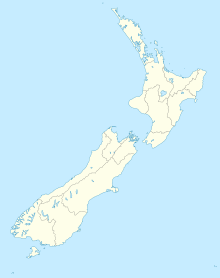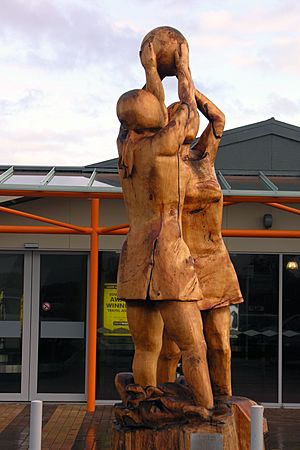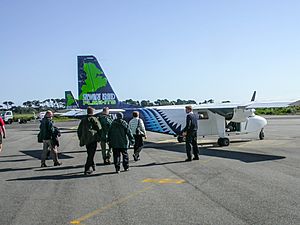Invercargill Airport facts for kids
Quick facts for kids
Invercargill Airport
|
|||||||||||||||||||||||
|---|---|---|---|---|---|---|---|---|---|---|---|---|---|---|---|---|---|---|---|---|---|---|---|
| Summary | |||||||||||||||||||||||
| Airport type | Public | ||||||||||||||||||||||
| Operator | Invercargill Airport Ltd | ||||||||||||||||||||||
| Location | Invercargill | ||||||||||||||||||||||
| Elevation AMSL | 5 ft / 2 m | ||||||||||||||||||||||
| Coordinates | 46°24′44″S 168°18′46″E / 46.41222°S 168.31278°E | ||||||||||||||||||||||
| Map | |||||||||||||||||||||||
| Runway | |||||||||||||||||||||||
|
|||||||||||||||||||||||
| Statistics (2013) | |||||||||||||||||||||||
|
|||||||||||||||||||||||
Invercargill Airport (IATA: IVC, ICAO: NZNV) is an important airport in New Zealand. It is located just 1.6 kilometers (about one mile) west of the main city area of Invercargill. This airport is at the very bottom of the South Island of New Zealand. It is also the southernmost controlled airport in the Commonwealth.
The airport was built on land that was once part of the Waihopai/New River Estuary. This happened in 1938. Because of its location, the airport used to flood often. A big flood in 1984 made the airport unusable for two months. The Invercargill City Council thought about moving the airport. Instead, they built a large flood protection system. Even during its construction, heavy rain and high tides caused another flood in 1987. Luckily, there have been no flooding problems since then.
The airport has a main building for passengers and a backup building for international flights. It also has five places where planes can park. Invercargill Airport is the eleventh-busiest airport in New Zealand based on how many passengers use it.
Contents
A Look Back: The Airport's History
The land where Invercargill Airport sits today was once a tidal lake. This spot was chosen because it was closer to the city than the first airport, Dawson Farm. Dawson Farm was about 10 kilometers away.
Work to drain and prepare the land for the new airport started in 1936. A large canal and pumping system helped to keep the land dry. By 1939, a basic landing strip was ready for small planes. When World War Two began, the RNZAF (New Zealand's air force) used it as a backup field. The city council built two hangars, and the air force built a larger one. Simple office buildings were used for airport management.
First Flights and New Airlines
The first regular flights from Invercargill Airport started in 1944. Union Airways flew a Lockheed 10 Electra plane from Dunedin. At that time, the airport's passenger area was just two small sheds. Union Airways also offered a bus service to take passengers to the city center.
In 1947, the government took over all airlines and created NAC. The Electra planes were replaced with de Havilland DH.89s. In 1956, a new paved runway was built. A new, but temporary, passenger building was also added. This allowed larger Douglas DC-3 planes to start flying.
Around the early 1950s, a local airline called Amphibian Airways began flights to Stewart Island. They used Grumman Widgeon planes. These special planes could land on both water and land. They also helped reach isolated lighthouses. Later, other companies took over this route. Today, Stewart Island Flights still provides air service to Stewart Island.
How the Airport Grew Over Time
The main runway at Invercargill Airport was made longer over the years. This was done so bigger planes could land there. For example, NAC Fokker F27s started in 1961. Then came NAC Vickers Viscount planes in 1969. Finally, NAC's Boeing 737-200 planes began using the airport in 1975. Other large planes, like the RNZAF Boeing 727-100 and Ansett New Zealand BAe 146s, also used the runway easily. Today, the main runway is 2210 meters long.
Changes to the Passenger Terminal
The airport's passenger building was first built in 1963. It had a unique two-level design with a special roof. Its walls facing the planes were made of glass. This gave great views of the runway from the upper floor. There was also an outdoor viewing area on the ground level. Passengers and their friends could gather there. This area was closed to non-passengers in 2002.
The new building was built next to the smaller, temporary terminal from 1956. That old terminal became the area for freight and baggage. A new, taller control tower was built in 1962. In 1988, Air New Zealand added a jetway. This covered walkway made it easier for passengers to get on and off planes, especially in bad weather. Airlines also had special lounges for their frequent flyers.
Over time, the ground floor of the terminal became crowded. The upstairs area was often empty. Air New Zealand removed its jetway in 2012. The airport decided it was time to either fix up the ground floor or build a whole new terminal. The old building also needed to meet new earthquake safety rules.
A Brand New Terminal in 2016
In 2013, the airport announced plans for a new terminal building. It would cost $13.3 million. The old terminal was over 50 years old and had big earthquake safety problems. It was cheaper to build a new one than to fix the old one.
Construction of the new single-story building started in 2014. It was built in three stages over about 20 months. The new terminal opened in 2016. It is 2,900 square meters, which is a bit bigger than the old one. But it uses the space much better. Air New Zealand also put in a new lounge for its frequent flyers. The terminal uses local materials to show off the region's tourist attractions. It was designed so it can be made even bigger in the future. In 2019, new security areas for passengers and baggage were added. These are used for domestic and sometimes international flights.
Smaller Planes, More Flights
From 1975 to 1995, regular jet services flew into Invercargill. But then Air New Zealand changed its routes. Its smaller airline, Mount Cook Airline, started using 68-seat ATR 72 planes. These propeller planes were similar in size to the Viscount. They allowed more frequent flights, up to eight times a weekday. The larger 737 jets had only three flights a day.
Air New Zealand explained that smaller planes like the ATR (and later, Q300) meant more flight options. When Air Nelson also started flying the 50-seat Q300 to Invercargill, a new direct route to Wellington became available. This gave people in Southland direct access to New Zealand's capital city. However, this service stopped in January 2025 because not enough passengers were using it.
Jet Services Return
In December 2018, Air New Zealand announced it would start direct flights to and from Auckland. They would use the Airbus A320 jet. This service began on August 25, 2019. The first Airbus A320 arrived from Auckland that day. It departed Invercargill the next morning. These flights are scheduled for mornings on Monday, Tuesday, Thursday, and Friday. There is also a Saturday morning flight. Return flights are in the evenings on Monday, Wednesday, Thursday, Friday, and Sunday. This is Air New Zealand's longest domestic flight. During the Covid Global Pandemic from 2019 to 2021, flights to Auckland changed to midday return services. They have stayed that way since. Air New Zealand said the Auckland service showed that people wanted direct flights.
Becoming a "Secured" Airport
With jet services returning in 2019, Invercargill Airport had to meet international safety rules. This meant putting fences around the entire airport. They also upgraded their rescue vehicles. A screening area for passengers and X-ray machines for baggage were installed. The airport now has security patrols 24 hours a day. Being a "Secured" airport also means there are fewer rules for occasional international flights.
Invercargill Airport Today
In 2005, the runway was made longer to 2,210 meters. This cost NZ$5 million. As of 2012, it was the third-longest civilian runway in New Zealand. It can handle planes like the Boeing 737 and Airbus A320. It can also handle weight-restricted Boeing 777-200 and 787-9 type planes. The airport has a plan to handle planes that need to land there if their original destination is closed.
The areas where planes park were updated in 2019. Gates 1 and 2 now have concrete parking spots. This allows larger planes like the Airbus A321 to park facing the terminal. Air New Zealand planes are pushed back using special tractors. Gates 3, 4, and 5 are still marked for planes to turn in and out. The runway was resurfaced with new asphalt in 2011. This helped increase the weight limits for planes using it.
Airlines and What They Do
Air New Zealand is the main airline at Invercargill Airport. They use ATR-72 planes for flights to and from Christchurch. They use Airbus A320 jets for flights to and from Auckland. Air New Zealand also has a small maintenance area here. Up to three of their planes stay overnight for service.
Stewart Island Flights offers flights to Oban, the main town on Stewart Island. They fly up to three times a day. They also offer flights for pre-booked groups.
Mainland Air flies to and from Dunedin. This service is mainly for transferring medical staff daily. But if there are empty seats, the public can buy tickets on their website.
International Stops and Diversions
Since August 2019, Invercargill has been a "Fully Secured" international airport. Before that, it needed special permission for occasional international flights.
Invercargill Airport has wanted to be an international destination for a long time. But nearby Queenstown Airport became the main choice for direct jet flights. Still, Invercargill is now used as a place for international flights to refuel. It is also a designated airport for planes to land if Queenstown Airport closes due to bad weather. This is thanks to its longer runway.
Before 2023, a basic international terminal was in Hangar 2. Now, passengers use the secure facilities in the main terminal.
Since July 2012, Air New Zealand has used Invercargill as a technical stop. This happens when conditions in Queenstown make it hard for planes to take off with enough fuel for Australia. This could be due to bad weather or other reasons. In the past, these flights went through Christchurch. That added two hours to the trip. Going via Invercargill saves one hour. Passengers usually stay on the plane while it refuels.
Invercargill now has full border control measures for international flights. This includes chartered flights or diverted flights from Queenstown. Airport security and Customs Officers from the nearby Port of Bluff provide official immigration services.
On March 3, 2013, Invercargill handled over 400 international passengers. Their flights were diverted from Queenstown due to low clouds. On June 17, 2024, Virgin Australia Flight 148, a Boeing 737-800 from Queenstown to Melbourne, was diverted to Invercargill. This happened after one of its engines had a problem from a bird strike during takeoff from Queenstown.
Military and Antarctic Role
Invercargill Airport was only a backup airport during World War Two. Military operations have been rare since then. This is because Christchurch was chosen as the main base for Operation Deep Freeze in 1949. Dunedin's Taieri Aerodrome was used for shorter flights heading south.
Sometimes, Antarctic flights did land at Invercargill if Taieri was closed. Special rocket boosters were sometimes needed to help heavily loaded planes take off. After the runway was lengthened and paved, larger planes like the C-124 Globemaster and C-121 Constellation used the airport for emergencies and technical stops.
Today, the airport is visited by planes from the United States ANG, Australia's RAAF, Italy's Aeronautica Militare, and the RNZAF. This is part of their training for Antarctic flight diversions. The RNZAF has also used the airfield for their Wise Owl exercises about twice every ten years.
The largest plane that regularly lands at Invercargill is the Boeing C-17 Globemaster. Even larger planes like the USAF KC-10 Extenders, Lockheed C-141 Starlifters, and C-5 Galaxy have flown low over the runway for emergency diversion practice.
Airlines and Where They Fly
Passenger Flights
| Airlines | Destinations |
|---|---|
| Air New Zealand | Auckland, Christchurch |
| Stewart Island Flights | Oban |
See also
- List of airports in New Zealand
- List of airlines of New Zealand
- Transport in New Zealand
- List of busiest airports in New Zealand




